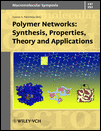Multi-Functional Conetworks Based on Cross-Linked Star Polymers
Abstract
Three series of conetworks based on cross-linked star polymers of different architectures were prepared using group transfer polymerization. The first series of conetworks were amphiphilic, based on the hydrophobic monomer benzyl methacrylate and the ionizable hydrophilic 2-(dimethylamino)ethyl methacrylate (DMAEMA); the second series were double-hydrophobic, based on methyl methacrylate and n-butyl methacrylate; the third series were ampholytic, based on the negatively ionizable methacrylic acid (MAA) and the positively ionizable DMAEMA. The MAA units were introduced into the conetworks via the polymerization of tetrahydropyranyl methacrylate followed by its acid hydrolysis after network formation. All the precursors to the conetworks were characterized in terms of their molecular weights using gel permeation chromatography. The degrees of swelling (DSs) of all the conetworks were measured as a function of pH or in a mixture of solvents. Moreover, the effect of the architecture of the conetworks on the DS was investigated. The DS was found to be influenced more by the charge density of the conetwork than by the compatibility with the solvent, and more by the solvent compatibility than by the architecture of the conetwork.




